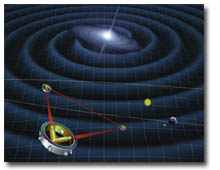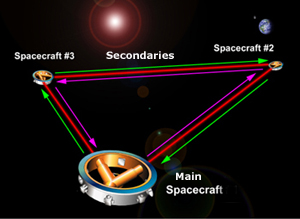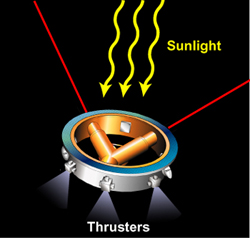Satellite Showcase
LISA
 |
|
Artist's concept of LISA shows the satellite in orbit around the Sun, following about 20 degrees behind the Earth. |
|
The Mission
The Laser Interferometer Space Antenna (LISA) is a next-generation project proposed by NASA to detect some of the weakest (and perhaps most interesting) gravitational waves. Gravitational waves are "ripples in spacetime" caused by large-scale events like galaxy coalescences, black hole collisions, and neutron star binary systems. The project uses the scientific technique of laser interferometry. Three separate spacecraft form three corners of a large triangle in space. Each of the three spacecraft establishes an independent orbit around the Sun, trailing the Earth's orbit by about 20 degrees. When a low-frequency gravitational wave passes, LISA will be able to detect slight changes in the distance between the corners of the triangle. The mission is expected to launch in 2011, with a mission life of about 5 years.
 |
|
LISA's interferometric spacecraft aim and detect laser signals that indicate passing gravitational waves. |
|
Instrumentation
LISA uses a scientific technique called laser interferometry. Interferometry uses two or more laser 'arms' to detect tiny fluctuations in distance. Here's how it works: A laser beam from one of the spacecraft is pointed toward a detector on another spacecraft, 5 million kilometers away. The laser beam precisely measures a distance between the two spacecraft. When the distance changes, an interference pattern is formed, and LISA has detected a gravitational wave. The three arms of the spacecraft work together to confirm each other's observations, as well as get more detailed dimensional information about the passing waveform. Why is LISA so big? As it turns out, the large distance between the detectors allows LISA to see variations smaller than the size of an atom! This observatory will be very sensitive!
 |
|
Thrusters help to keep LISA isolated from outside disturbances like pressure from solar radiation. |
|
A major challenge of the mission is to isolate LISA from disturbances in space that might mimic a gravitational wave. Variations in the Earth's gravitational field, or large solar events might cause such disturbances. To prevent these disturbances, each of LISA's three spacecraft is equipped with micro-Newton thrusters to keep the instruments steady.
Expected Science Results
Once LISA is launched, and starts to return data, scientists will compare it to computer models to interpret what they see. Dr. Joan Centrella and her team of theoretical researchers at NASA are creating what she calls a "numerical laboratory" of models that represent gravitational wave phenomena. Using these waveform computer codes, scientists will be able to decipher LISA's message. They will be able to sift through the information, isolating sources of gravitational waves as well as the behaviors that cause them. The scientists behind the LISA mission hope to detect information about black holes and the Big Bang, as well as proof of Einstein's famous Theory of General Relativity.
See what LISA could tell us about Black Holes, General Relativity, and The Big Bang.
Additional Links
 LISA Home Page (http://lisa.jpl.nasa.gov) LISA Home Page (http://lisa.jpl.nasa.gov)
|
